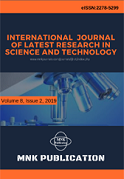DOI:10.29111/ijlrst ISRA Impact Factor:3.35, Peer-reviewed, Open-access Journal
Open Access
International Journal of Latest Research in Science and Technology Vol.8 Issue 3, pp 0-0,Year 2019
Received : 01 May 2019; Accepted : 13 June 2019 ; Published : 30 June 2019

| Download | 127 |
|---|---|
| View | 187 |
| Article No. | 10976 |
Fuel is any material that is capable of releasing energy on altering its chemical or physical structure. Throughout history man has always pursued better sources of fuel to meet his energy needs. The current trend is towards renewable fuels such as biofuels derived from both plant and animal residue. Manihot peel generated during processing of cassava tubers are potential sources of biofuel if properly harnessed. This study investigated alternative fuels from cassava peels. Dried, milled manihot peel which passed through sieve size 10 (2 mm) were used as feedstock for biogas, bioethanol and briquette production. The percentage starch contained in the sample was evaluated by hydrolytic and spectrophotometric methods. Biogas was generated from anaerobic digestion of neutralized 25% w/w solid content sample slurry using 0.1 M sodium hydroxide in a bio-digester for 30 days retention period. The pressure of the biogas was measured with a U-tube manometer (KAYLA 2516) and its volume was determined using Boyle’s Law. Methane content was analyzed with biogas analyzer (ASTM 2188). Acid hydrolysis was carried out using diluted 0.1 M hydrochloric acid while alpha amylase (Termamyle 170) and glucoamylase were used for enzymatic hydrolysis. The hydrolysates from both processes were fermented with ethanol tolerant yeast (Saccharomyces cerevisiae) to produce liquor which was further distilled to bioethanol. Ethanol content of the bioethanol was determined using alcoholometric table No. 913.02 of the Association of Official Analytical Chemists at 30oC. Cassava briquette was produced from the compaction of a slightly moistened sample and the bulk density was determined. Mineral ash content was evaluated with plain photometric and atomic absorption spectrophotometric methods. The combustion heat and High Heating Value (HHV) for the bioethanol and briquette respectively were obtained in a bomb calorimeter (e2k) while that of biogas was evaluated using combustion equation. The results revealed that the percentage starch in the sample was 9.84%. The volume, methane content, carbon (IV) oxide content and combustion heat of the biogas were 0.588 l, 60.72%, 33.97% and 13.51 kJ respectively. The volume, ethanol content and combustion heat of the bioethanol, while they were 1560 ml, 68.93% and 68.20 kJ for the enzymatic hydrolysis, they were 1400 ml, 67.64% and 57.40 kJ for the acid hydrolysis processes. It can be concluded from the study that production of biogas, and bioethanol are viable from manihot peel.
Copyright © 2019 et al. This is an open access article distributed under the Creative Commons Attribution 4.0 International (CC BY 4.0) license which permits unrestricted use, distribution, and reproduction in any medium, provided the original work is properly cited.
, " The Potential Of Manihot Peel Applicable Technologies For Substainable Biogas - Bio Ethanol Production ", International Journal of Latest Research in Science and Technology . Vol. 8, Issue 3, pp 0-0 , 2019

MNK Publication was founded in 2012 to upholder revolutionary ideas that would advance the research and practice of business and management. Today, we comply with to advance fresh thinking in latest scientific fields where we think we can make a real difference and growth now also including medical and social care, education,management and engineering.

We offers several opportunities for partnership and tie-up with individual, corporate and organizational level. We are working on the open access platform. Editors, authors, readers, librarians and conference organizer can work together. We are giving open opportunities to all. Our team is always willing to work and collaborate to promote open access publication.

Our Journals provide one of the strongest International open access platform for research communities. Our conference proceeding services provide conference organizers a privileged platform for publishing extended conference papers as journal publications. It is deliberated to disseminate scientific research and to establish long term International collaborations and partnerships with academic communities and conference organizers.